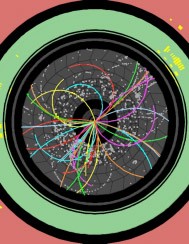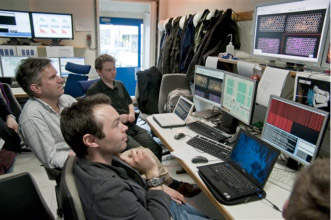Researchers mark CERN milestone

The School of Physics & Astronomy is part of today’s significant developments at the European Organisation for Nuclear Research (CERN).
Physicists from the University of Edinburgh are working at the Large Hadron Collider (LHC) as it starts to smash sub-atomic particles together with a record level of energy – 7 trillion electron-volts (TeV).
The powerful particle collisions mark the beginning of LHC’s first high-energy activity.
Experiments at the LHC will collect data that may provide evidence of the Higgs boson. The existence of this theoretical particle was first postulated by Professor Peter Higgs when he was a researcher at the University in the 1960s. It will be a remarkable achievement for physics if his predictions are correct.
About 20 physicists from the University perform research at CERN, working on the ATLAS and LHCb detectors which analyse collision data from the LHC as it recreates the conditions of the Big Bang.
The researchers’ work on ATLAS involves modelling and simulating the particle collision process to help understand the detector’s response and the complex data produced by the experiments. They also contribute to the operation of the ATLAS detector itself and provide software to manage the data produced.
Dr Philip Clark, School of Physics and Astronomy, said, “We are delighted to be involved with CERN as the new high-energy run gets under way. The Large Hadron Collider is expected to advance significantly our knowledge of physics and as such represents an enormously important development.”
The Edinburgh group works on the Ring Imaging Cherenkov (RICH) detectors for the LHCb experiment. The RICH detectors are built to distinguish between kaons and pions, which are different types of charged particles. Their proper identification is crucial for measuring differences between particles and antiparticles. The LHCb experiment aims to understand the matter-antimatter asymmetry in the Universe.
Prof. Franz Muheim, School of Physics and Astronomy, states: “Today is the start of a new era for particle physics. We have worked hard over more than a decade to design, build and commission the LHCb experiment. Thus we are very excited to have started data-taking at the LHC. This is a giant step into unknown territory and the LHC will hopefully reveal a few secrets of Nature.”
The LHC research may shed light on other important unsolved questions in physics. These include furthering scientists’ knowledge of dark matter and explaining why the Universe is made from matter, not anti-matter.
Physics exhibition
To mark today’s CERN milestone, the School is holding an exhibition in the forum of the University’s Main Library. This will be followed by a presence at the Science Festival.
The display, which is run by Alan Walker of the Particle Physics Experiment group, features a series of experiments relating to particle physics and the search for the Higgs boson.
Picture gallery

An LHCb event recorded at 7 TeV

Happy researchers in the LHCb control room, including Conor Fitzpatrick (foreground), a 2nd year PhD student, who is involved in calibrating the RICH detectors.

